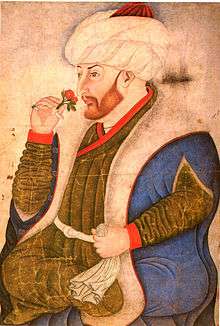Sultan
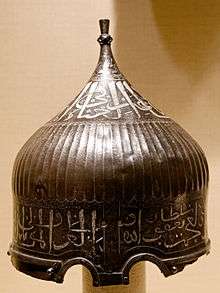 |
|
|
Sultan (/ˈsʌltən/; Arabic: سلطان sulṭān, pronounced [sʊlˈtˤɑːn, solˈtˤɑːn]) is a noble title with several historical meanings. Originally, it was an Arabic abstract noun meaning "strength", "authority", "rulership", derived from the verbal noun سلطة sulṭah, meaning "authority" or "power". Later, it came to be used as the title of certain rulers who claimed almost full sovereignty in practical terms (i.e., the lack of dependence on any higher ruler), albeit without claiming the overall caliphate, or to refer to a powerful governor of a province within the caliphate.
The dynasty and lands ruled by a sultan are referred to as a sultanate (سلطنة salṭanah).
A feminine form of sultan, used by Westerners, is sultana or sultanah; but Turkish and Ottoman Turkish uses "Sultan" for all women, because Turkish grammar uses the same words for women and men. However, this styling misconstrues the roles of wives of sultans. In a similar usage, the wife of a German field marshal might be styled Frau Feldmarschall (in French, similar constructions of the type madame la maréchale are quite common). The female leaders in Muslim history are correctly known as "sultanas". However, the wife of the sultan in the Sultanate of Sulu is styled as the "panguian" and sultan's chief wife in many sultanate in Indonesia and Malaysia is known as "permaisuri" or "Tunku Ampuan", "Raja Perempuan" or "Tengku Ampuan". Special case in Brunei, the Queen Consort is known as Raja Isteri with suffix Pengiran Anak if the queen consort is a royal princess.
Among those modern hereditary rulers who wish to emphasize their secular authority under the rule of law, the term is gradually being replaced by king (i.e. malik in Arabic) and Datu in Maranao.
Compound ruler titles
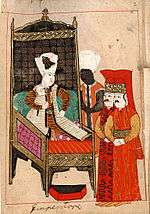
These are generally secondary titles, either lofty 'poetry' or with a message, e.g.:
- Mani Sultan = Manney Sultan (meaning the "Pearl of Rulers" or "Honoured Monarch") - a subsidiary title, part of the full style of the Maharaja of Travancore
- Sultan of Sultans - the sultanic equivalent of the style King of Kings
- Certain secondary titles have a devout Islamic connotation; e.g., Sultan ul-Mujahidin as champion of jihad (to strive and to struggle in the name of Allah).
- Sultanic Highness - a rare, hybrid western-Islamic honorific style exclusively used by the son, daughter-in-law and daughters of Sultan Hussein Kamel of Egypt (a British protectorate since 1914), who bore it with their primary titles of Prince (Amir; Turkish: Prens) or Princess, after 11 October 1917. They enjoyed these titles for life, even after the Royal Rescript regulating the styles and titles of the Royal House following Egypt's independence in 1922, when the sons and daughters of the newly styled king (malik Misr, considered a promotion) were granted the title Sahib(at) us-Sumuw al-Malaki, or Royal Highness.
Former sultans and sultanates
Anatolia and Central Asia
- Ghaznavid Sultanate
- Sultans of Great Seljuk
- Seljuk Sultanate of Rum
- Sultans (becoming padishahs) of the Ottoman Empire, the Osmanli
Caucasus
- Elisu Sultanate and a few others. A Sultan ranked below a Khan.
Levant and Arabian peninsula

- in Syria:
- in present-day Yemen, various small sultanates of the former British Aden Protectorate and South Arabia:
- Audhali, Fadhli, Haushabi, Kathiri, Lahej, Lower Aulaqi, Lower Yafa, Mahra, Qu'aiti, Subeihi, Upper Aulaqi, Upper Yafa and the Wahidi sultanates
- in present-day Saudi Arabia :
- Oman – Sultan of Oman (authentically referred to as Hami), on the southern coast of the Arabian peninsula, still an independent sultanate, since 1744 (assumed the formal title of Sultan in 1861)
North Africa

- in Algeria: sultanate of Tuggurt
- in Egypt:
- in Morocco, until Mohammed V changed the style to Malik (king) on 14 August 1957, maintaining the subsidiary style Amir al-Mu´minin (Commander of the Faithful)
- in Sudan:
- Darfur
- Dar al-Masalit
- Dar Qimr
- Funj Sultanate of Sinnar (Sennar)
- Kordofan
- in Chad:
- Bag(u)irmi (main native title: Mbang)
- Wada'i (main native title: Kolak), successor state to Birgu
- Dar Sila (actually a wandering group of tribes)
Horn of Africa
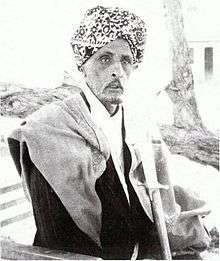
- Adal Sultanate, in northwestern Somalia, southern Djibouti, and the Somali, Oromia, Harari, and Afar regions of Ethiopia
- Ajuran Sultanate, in southern Somalia and eastern Ethiopia
- Majeerteen Sultanate (Migiurtinia), in northern Somalia
- Marehan Sultanate, in northern Somalia
- Sultanate of the Geledi, in southern Somalia
- Sultanate of Aussa, in northeastern Ethiopia
- Sultanate of Harar, in eastern Ethiopia
- Sultanate of Hobyo, in Somalia
- Sultanate of Ifat, in eastern Ethiopia
- Sultanate of Mogadishu, in south-central Somalia
- Sultanate of Showa, in central Ethiopia
- Warsangali Sultanate, in northern Somalia
Southeast Africa and Indian Ocean
- Angoche Sultanate, on the Mozambiquan coast (also several neighbouring sheikdoms)
- various sultans on the Comoros; however on the Comoros, the normally used styles were alternative native titles, including Mfalme, Phany or Jambé and the 'hegemonic' title Sultani tibe
- the Maore (or Mawuti) sultanate on Mayotte (separated from the Comoros)
Maliki
This was the alternative native style (apparently derived from malik, the Arabic word for "king") of the sultans of the Kilwa Sultanate, in Tanganyika (presently the continental part of Tanzania).
Swahili Coast
- Sultanate of Zanzibar: two incumbents (from the Omani dynasty) since the de facto separation from Oman in 1806, the last assumed the title Sultan in 1861 at the formal separation under British auspices; since 1964 union with Tanganyika (part of Tanzania)
Mfalume is the (Ki)Swahili title of various native Muslim rulers, generally rendered in Arabic and in western languages as Sultan:
- in Kenya:
- Pate on part of Pate island (capital also named Pate), in the Lamu Archipelago
- Wituland, came under German, then British protectorate
- in Tanganyika (presently part of Tanzania): of Hadimu, on the island of that name; also styled Jembe
Sultani
This was the native ruler's title in the Tanzanian state of Uhehe a female sultan
West and Central Africa
- In Cameroon:
- Bamoun (Bamun, 17th century, founded uniting 17 chieftaincies) 1918 becomes a sultanate, but in 1923 re-divided into the 17 original chieftaincies.
- Bibemi, founded in 1770 - initially styled lamido
- Mandara Sultanate, since 1715 (replacing Wandala kingdom); 1902 Part of Cameroon
- Rey Bouba Sultanate founded 1804
- in the Central African Republic:
- Bangassou created c.1878; 14 June 1890 under Congo Free State protectorate, 1894 under French protectorate; 1917 Sultanate suppressed by the French.
- Dar al-Kuti - French protectorate since December 12, 1897
- Rafai c.1875 Sultanate, 8 April 1892 under Congo Free State protectorate, March 31, 1909 under French protectorate; 1939 Sultanate suppressed
- Zemio c.1872 established; December 11, 1894 under Congo Free State protectorate, April 12, 1909 under French protectorate; 1923 Sultanate suppressed
- in Niger: Arabic alternative title of the following autochthonous rulers:
- the Amenokal of the Aïr confederation of Tuareg
- the Sarkin Damagaram since the 1731 founding of the Sultanate of Damagaram (Zinder)
- in Nigeria most monarchies previously had native titles, but when most in the north converted to Islam, Muslim titles were adopted, such as emir and sometimes sultan.
- in Borno (alongside the native title Mai)
- since 1817 in Sokoto, the suzerain (also styled Amir al-Mu´minin and Sarkin Musulmi) of all Fulbe jihad states and premier traditional Muslim leader in the Sahel (according to some once a caliph)
Southern Asia
.jpg)
- Bahmani Sultanate
- the Deccan sultanates: Berar, Bidar, Bijapur, Golconda and Ahmednagar
- Delhi Sultanate: several dynasties, the last (Mughal) became imperial Padshah-i Hind
- Bengal Sultanate
- Sultanate of Gujarat
- Sultanate of Jaunpur
- Sultanate of Kandesh
- Sultanate of Malwa
- Sultanate of Mysore, Tipu Sultan
- Sultanate of Lakshadweep and Cannanore, Arakkal Kingdom
- Sultanate of Maldives
Southeast and East Asia

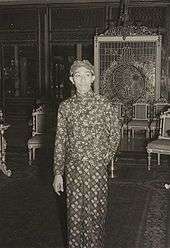
In Indonesia (formerly in the Dutch East Indies):
- On Kalimantan
- Sultanate of Banjar
- Sultanate of Berau
- Sultanate of Bulungan
- Sultanate of Gunung Tabur
- Sultanate of Kubu
- Sultanate of Kutai Kartanegara
- Sultanate of Mempawah
- Sultanate of Paser
- Sultanate of Pontianak
- Sultanate of Sambaliung
- Sultanate of Sambas
- On Sulawesi
- Sultanate of Buton
- Sultanate of Bone
- Sultanate of Gowa
- Sultanate of Luwu
- Sultanate of Soppeng
- Sultanate of Wajo
- On Java
- Sultanate of Banten
- Sultanate of Cirebon - the rulers in three of the four palaces (kraton), from which divided Cirebon was ruled: Kraton Kasepuhan, Kraton Kanoman and Kraton Kacirebonan (only in Kraton Kaprabonan was the ruler's title Panembahan)
- Sultanate of Demak
- Sultanate of Pajang
- Sumedang Larang Kingdom
- Sultanate of Mataram (was divided into two kingdoms: the Sultanate of Yogyakarta and Sunanan Surakarta)
- Sultanate of Yogyakarta (The Divine Sultanate of which its ruler Sri Sultan Hamengkubowono is considered a divine being, a half God)
- Sunanate of Surakarta (susuhunan, a high-ranked monarch, equivalent to emperor)
- Sultanate of Jayakarta (also known as Sunda Kelapa; modern-day Jakarta)
- On Madura island: Pamekasan
- In the Maluku Islands
- Sultanate of Iha (Saparua)
- Sultanate of Honimoa/ Siri Sori (Saparua)
- Sultanate of Huamual (West Seram)
- Sultanate of Tanah Hitu (Ambon)
- Sultanate of Ternate
- Sultanate of Tidore
- Sultanate of Bacan
- Sultanate of Jilolo
- Sultanate of Loloda, later occupied by Ternate
- In the Nusa Tenggara
- Sultanate of Bima on Sumbawa island
- In the Riau archipelago: sultanate of Lingga-Riau by secession in 1818 under the expelled sultan of Johore (on Malaya) Sultan Abdul Rahman Muadzam Syah ibni al-Marhum Sultan Mahmud
- In Sumatra
- Sultanate of Aceh (full style Sultan Berdaulat Zillullah fil-Alam), which had many vassal states
- Sultanate of Asahan
- Awak Sungai, established 17th century at the split in four of Minangkabau, in 1816 extinguished by Netherlands East Indies colonial government
- Sultanate of Deli since 1814, earlier Aceh's vassal as Aru
- Sultanate of Indragiri
- Sultanate of Langkat since 1817 (previous style Raja)
- Sultanate of Palembang (Darussalam), also holding the higher title of Susuhunan
- Sultanate of Pagaruyung
- Sultanate of Pelalawan
- Sultanate of Perlak
- Sultanate of Riau-Lingga
- Sultanate of Samudera Pasai
- Sultanate of Serdang
- Sultanate of Siak Sri Inderapura
In Malaysia:
- In Peninsular Malaysia, where all nine of the country's present sultanates are located:
- Furthermore, the ruler of Luak Jelebu, one of the constitutive states of the Negeri Sembilan confederation, had the style Sultan in addition to his principal title Undang Luak Jelebu.
In Brunei:
- Sultan of Brunei, Brunei (on Borneo island)
In China:
- Dali, Yunnan, capital of the short-lived Panthay Rebellion
- Furthermore, the Qa´id Jami al-Muslimin (Leader of the Community of Muslims) of Pingnan Guo ("Pacified South State", a major Islamic rebellious polity in western Yunnan province) is usually referred to in foreign sources as Sultan.
In the Philippines:
- Sultanate of Buayan
- Sultanate of Maguindanao
- Sultanate of Sulu (Sulu, Basilan, Palawan and Tawi-Tawi islands and part of eastern Sabah on North Borneo)
- Sultanate of Ranaw (Sultan ko Pat a Pangampong a Ranao)
In Thailand:
Contemporary sovereign sultanates
- Brunei
- Indonesia – Sultan of Yogyakarta Special Region is governor of that province
- Malaysia
- Sultan is the title of seven (Johor, Kedah, Kelantan, Pahang, Perak, Selangor and Terengganu) of the nine rulers of the Malay states. The federal head of state the Yang di-Pertuan Agong, is elected (de facto rotated) for five years by and among the hereditary state rulers, but is usually styled "king" in foreign countries; political power, however, lies with the prime minister. See also: Malay titles
- Oman, an Arabian nation, formerly sultanate of Muscat and Oman
In some parts of the Middle East and North Africa, there still exist regional sultans or people who are descendants of sultans and who are styled as such.
Princely and aristocratic titles

By the beginning of the 16th century, the title sultan was carried by both men and women of the Ottoman dynasty and was replacing other titles by which prominent members of the imperial family had been known (notably khatun for women and bey for men). This usage underlines the Ottoman conception of sovereign power as family prerogative.
Western tradition knows the Ottoman ruler as "sultan", but Ottomans themselves used "padişah" (emperor) or "hünkar" to refer to their ruler. The emperor's formal title consisted of "sultan" together with "khan" (for example, Sultan Suleiman Khan). In formal address, the sultan's children were also entitled "sultan", with imperial princes (Şehzade) carrying the title before their given name, with imperial princesses carrying it after. Example, Şehzade Sultan Mehmed and Mihrimah Sultan, son and daughter of Suleiman the Magnificent. Like imperial princesses, living mother and main consort of reigning sultan also carried the title after their given names, for example, Ayşe Hafsa Sultan, Suleiman's mother and first valide sultan, and Hürrem Sultan, Suleiman's chief consort and first haseki sultan. The evolving usage of this title reflected power shifts among imperial women, especially between Sultanate of Women, as the position of main consort eroded over the course of 17th century, the main consort lost the title "sultan", which replaced by "kadin", a title related to the earlier "khatun". Henceforth, the mother of the reigning sultan was the only person of non imperial blood to carry the title "sultan".[1]
In Kazakh Khanate a Sultan was a lord from the ruling dynasty (a direct descendants of Genghis Khan) elected by clans, i.e. a kind of princes. The best of sultans was elected as khan by people at Kurultai. See ru:Казахские султаны
Military rank
In a number of post-caliphal states under Mongol or Turkic rule, there was a feudal type of military hierarchy. These administrations were often decimal (mainly in larger empires), using originally princely titles such as khan, malik, amir as mere rank denominations.
In the Persian empire, the rank of sultan was roughly equivalent to that of a modern-day captain in the West; socially in the fifth-rank class, styled 'Ali Jah.
See also
- Other ruling titles
- Khan (title), Ilkhan and Khakhan
- Emir (Amir)
- Atabeg
- Bey
- Baig
- Mirza
- Caliph
- Datu
- Maharajah
- Malik
- Mir (title)
- Padishah
- Raja
- Shah and Shahanshah
- Zoltán
References
| Wikimedia Commons has media related to Sultans. |
